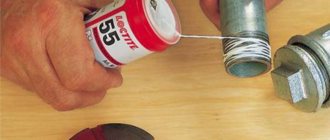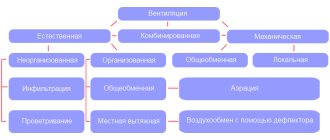If you are building a country house or are seriously renovating an existing one, already at the planning stage you need to take care of how the premises will be heated during the cold season.
Correct design of heating systems in private residential construction is a guarantee of winter comfort, rational use of resources and efficient operation of equipment.
In this material we will look at heating systems for a private home, tell you how to choose the best option and show with an example how to properly design a heating system.
Prices for heating design
| № | Job title | Description | Unit | Cost in rubles |
| 1 | Heating system design | Project composition:
| m2 | 80 |
| 2 | Design of an underfloor heating system | Project composition:
| m2 | 80 |
| 3 | Design work on the water supply system | Project composition:
| m2 | 50 |
| 4 | Design work on the sewerage system | Project composition:
| m2 | 50 |
| 5 | Design work on the ventilation system | Project composition:
| m2 | 60-120 |
| 6 | Design work on the air conditioning system | Project composition:
| m2 | 70 |
| 7 | Boiler room project | Project composition:
| set | from 7000 |
| 8 | Project of low-current systems. | Project composition:
| m2 | 70 |
| 9 | Visualization of the boiler house project in 3D | Project composition:
| set | from 9600 |
| 10 | Visit of the designer to the site | When concluding a contract, the amount goes towards payment for design work. | 2100 | |
| 11 | Thermal calculation | Calculation of heat losses of a building. | m2 | 25 |
| 12 | Transferring drawings from paper to electronic form | m2 | 25 |
Preliminary design
The preliminary design (ED) of the heating system is intended to determine the requirements for the facility's solutions and confirm the feasibility of its creation. Sometimes the preliminary design stage is skipped and all the work envisaged at this stage is carried out at the feasibility study stage. We do not take this approach.
Our company is ready to offer several options already at the ES stage. The preliminary design is carried out with the preparation of an explication of the main equipment, equipment brand and manufacturer. This allows you to choose the optimal and less expensive way to solve the problem at a very early stage.
Technical specifications and commercial proposal
At the second stage, based on the approved preliminary design and preliminary calculations, the following are developed:
- a document containing a text description of the heating system being created - technical specifications (TOR);
- and possible investment costs for its creation - commercial proposal (CP).
Customers often come to us with the question: “How much do the services of your specialists cost and how much will the heating system of my home (workshop, enterprise, etc.) cost me?” At the same time, the person who asked such a question does not have any project for the desired heating system, and sometimes there is no answer to the question to himself: “What do I want?” Naturally, we cannot give a quick answer to such a question, and we have to explain for a very long time why we cannot do this. Therefore, we present below a standard form of technical specifications for the design of a heating system, from which it is clearly visible how many questions the designer needs to answer in order to complete the design work. And this is not a complete range of all issues. And only on the basis of the finished project, the estimator already has the opportunity to issue an estimate for the facility. And for us, as specialists, one thing is unequivocally clear: if someone “out of the blue” says the price, then this is just a shameless deception of the customer and nothing more. Miracles don't happen.
Objects
Design is carried out only by qualified specialists with experience and high professional skills in solving engineering problems of any degree of complexity for objects for various purposes :
- Offices and administrative buildings
- Apartments and cottages
- Cafes and bars
- Swimming pools
- Retail premises
- Industrial buildings and premises
- Gyms, fitness centers
- Cultural and entertainment institutions (cinemas, entertainment centers)
- Hotels
- Parking lots, car services, gas stations
- Sanatoriums, boarding houses, holiday homes
- “Clean rooms”, clinics, hospitals
- And other objects...
Our objects
Heating project - a complete package of design documentation
The fourth stage is the implementation of work on drawing up complete specifications for heating equipment and materials, as well as the execution of project documentation in a form that complies with established norms and rules.
Carrying out work in all four stages allows you to create a complete package of design documentation, which is called a heating project. The proposed heating system projects allow us to carry out all further installation work on the installation of equipment with high quality.
Heating scheme for a private house
To understand the heating scheme of a private house built with your own hands, you need to know some rules. They relate to installation work, as well as the competent selection of heating equipment, pipe routing and type of heating system. In this article we will analyze all the schemes and find out what nuances need to be taken into account for the system to work effectively.
Let’s immediately decide that we will consider only water heating using boilers and pipes. Firstly, this system is considered the simplest and most reliable. And, secondly, you can select such a scheme and build such a system that its operation will be effective and the practical side of the matter will be respected.
The operating principle of such a heating system is as follows. The coolant in the heating boiler heats up and flows through the pipeline into the heating devices - radiators. Here it gives off heat and returns through the return circuit to the boiler. And the whole process is repeated again. It turns out that water heating is a kind of cyclical technological process.
Color combinations
Stylists advise taking into account the following nuances:
- direction in the interior;
- combination of shades;
- illumination
It is much easier to choose a palette if the style for the kitchen and living room has already been selected. For example, neoclassicism and Provence have their own combinations. In a classic interior, designers combine pastel colors, pale colors, which are slightly diluted with dark shades. In French country houses you can often see soft blue, pink, and pistachio colors. Art Deco designers make up objects and finishing materials in black and white, sometimes beige and brown or silver and black. The main thing is to choose a shade for the walls. White will become universal, it will expand the space, and later you can paint them with any paint. However, in the cooking area, white ceases to look fresh. Beige or gray shades would be more practical. This background will highlight the other colors. In a monochrome interior, designers recommend gluing wallpaper in an unusual color or with a photo print.
Types of heating schemes
So, what is the best heating scheme for a private house? There are two of them:
- Single-pipe.
- Two-pipe.
Single pipe system
Of the two above, this is the cheapest and simplest system. It is a ring into which heating radiators are installed in sequential order. The coolant moves from radiator to radiator until it passes through everything and returns to the boiler. Very simple.
It would seem that such a scheme should be optimal, because simplicity and economy are often the fundamental factors influencing the choice.
But not everything is as simple as it seems at first glance. Judge for yourself. The coolant, heated to a certain temperature (usually +75 C), moves to the first heating device. It gives off a certain amount of heat to it, while cooling down by several degrees.
Single-pipe heating circuit
In the second radiator it is not yet clear that the coolant has cooled down. But already in the fourth or fifth it will be noticeable.
Having reached the last radiator, the coolant will have a temperature of approximately +45 C. And at this temperature the room cannot be warmed up.
What to do? There are two ways out:
- Increase the number of sections of the latest radiators, thereby increasing the heat transfer area.
- Increase the temperature of the coolant leaving the heating boiler. And this will require more fuel consumption.
Both options have an economic component, which, unfortunately, is distributed not in the direction of decreasing costs, but, on the contrary, in the direction of increasing them. And here you have to choose what is best for you.
There is another option. This is a circuit with forced coolant circulation. What it is?
This is when the heating system contains a unit, usually a circulation pump, that creates a slight pressure inside it. It ensures uniform distribution of coolant across all radiators. In addition, hot water moves through the system at low speed, and this affects the inertia of the system, so that rapid heating occurs.
This option is more effective than the first two, but the circulation pump installed in the system operates from an electric current network. What is the inconvenience?
- Firstly, it consumes a little electrical energy, but this is an additional expense.
- Secondly, if there is no electricity, then there is no pressure inside the heating. And in winter, turning off the power supply in suburban villages is not uncommon.
Two-pipe system
Two-pipe heating system for a residential building
To say that it is better than the first is to say nothing. This scheme works much more efficiently, because each radiator has its own separate pipe with coolant. But they have the same return circuit. And from each radiator a separate pipe descends to the return line, through which the coolant is discharged.
In general, this system is not complicated. You only need to choose how the coolant will be supplied to the radiators - using a radial or collector circuit.
In the first case, the supply pipe rises up to the ceiling into the attic, where each pipe has its own individual pipe. The result is a kind of contour, similar to the sun, where in the center there is a pipe from the boiler, and rays of pipes diverge to the sides to radiators. Hence its name - radial.
The collector circuit is considered more modern. A special device called a collector is installed in the attic. It consists of a pipe structure through which the coolant is distributed throughout the system. Shut-off valves are also installed here, cutting off each circuit.
This makes the system convenient to operate and also simplifies the repair process if necessary. Thus, it is possible to repair not only a separate circuit supplying a room, but even a separate radiator.
In all respects, the collector circuit is superior to others. But a two-pipe system, and even more so a collector system, has one significant drawback. This is a large amount of material used to construct this circuit. This includes a pipe, shut-off valves, monitoring and regulating devices and sensors. Therefore, you will have to fork out money here. But if you want your house to always be warm in all rooms, then this is the scheme that will help you do this.
Single-circuit systems with natural circulation
Is it possible to install a circulation pump in a two-pipe heating system? How relevant is this? There is no great need for this, because the two-pipe system with natural circulation works efficiently. So there is no need for extra expenses.
Now we return to the question of whether it is possible to build a heating system in a private house with your own hands. Here, as elsewhere, much will depend on your skills in using different tools and experience in installation work. If you have neither one nor the other, the consequences may not be very rosy.
First of all, the boiler will boil, and the batteries will be cold. If the slope of the upper pipe distribution is incorrectly made, the rooms will be cool, even with a hot boiler. The same applies to the return loop.
If you install the circulation pump in the wrong place, it will work for one season and stop, start leaking, that is, problems will appear. Well, if you install the expansion tank incorrectly, you will end up with a lack of coolant in the system.
And many more such nuances can be listed. So, ideally, installation of a heating system is the work of craftsmen. But if you want to save money and your budget is tight, you will have to study.
Air
Such a system can be installed exclusively at the construction stage. It is not suitable for a finished private house. This is explained by the need to install metal, plastic or textile air ducts through which hot air heated by the heat generator is blown out.
A warm flow enters the room from under the ceiling and displaces cold air, which, in turn, returns through the air ducts to the heat generator.
Designing heating using the air heating method allows you to install a system for external intake of clean air, which is mixed with the flow. Circulation can be achieved by gravity or by force.
Natural air exchange occurs due to temperature differences, and forced air exchange is carried out using special ventilation equipment. The heat generator can burn diesel fuel, natural gas (mainline or bottled) and kerosene. Combustion products are discharged through the chimney.
Which heating boiler to choose?
It's no secret that there is a fairly large selection of modern heating boilers. They are divided into types according to the fuel on which they operate. Which one to choose depends on the circumstances. The basis is the fuel that is easiest to find in your region and which is cheaper than all others.
Currently, manufacturers offer combined models that run on two types of fuel. For example, gas and firewood, gas and electricity, coal and electricity, firewood and diesel fuel. When one fuel runs out, it can be replaced with another. Therefore, my advice is to choose the boiler that is convenient for you both in terms of fuel supply and in terms of operation and maintenance.
Heating pipes
REHAU metal-plastic pipe
Which pipes are better? For water heating, the best option is metal-plastic pipes that can withstand high temperatures. But if a solid fuel boiler is installed in the heating system of a private house, then it is better to use metal pipes. After all, sometimes the temperature of the coolant leaving the boiler can be more than +100C, and plastic will not be able to withstand it.
When choosing heating installation schemes in a private house, you need to carefully think through everything, weigh it and approve the budget exclusively for heating at the family council. It is from money that you will have to dance. If the budget is large, then you can install a two-pipe circuit, and even with a manifold and pump. If it’s small, then you can get by with a single-pipe circuit. But if you add a little money and buy a circulation pump, then even this system will work well.
- Example 1. Design of a heating system with connection of radiators using a two-pipe scheme
- Example 2. Design of a heating system with connection of radiators using a single-pipe scheme
- Example 3. Design of a heating system with connection of radiators using a manifold circuit
After a hydraulic calculation, it may turn out that the resistance of the heating system is too high. You can, of course, purchase a more powerful circulation pump. It is possible, as already suggested in the previous article, to increase the diameters of the pipes. But there is another option: change the way the radiators are connected. Therefore, I decided to add this article, which looks at examples of heating system projects for the same house.
In previous materials, I performed calculations for a two-pipe heating system. You can replace it with a single-pipe one and perform all the calculations using a new one...
Well, not everything, of course: there is no need to re-calculate heat loss. And also there is no need to re-calculate the radiator sections. We are talking only about hydraulic calculations.
So, as I already said, below are three examples of a project for the same house, but in each example the radiators are connected according to a different circuit. All these schemes have already been discussed, but I think it will be useful to refresh your memory.
Other tips
The living room with the kitchen can be combined and decorated with various shortcomings
It is important to calculate and anticipate everything in advance. Decorators and craftsmen share tips that will help avoid problems during repairs and furnishings:
The result depends on how detailed the project is drawn up. Oddly enough, it is worth taking into account the growth of loved ones and relatives. It is also recommended to calculate the approximate number of possible guests. You can get rid of food smells by installing a strong hood or ventilation system.
Small models are more suitable for housewives who do little cooking. If you plan to have a sleeping place in the living room, then it is important that the ringing of appliances and other kitchen utensils is not heard. Silent dishwashers and other appliances will come in handy.
In addition, you can install a sliding door and install a soundproof partition. If there is sensitivity to ultraviolet radiation, the owners hang thick curtains made of light-proof fabric. If household appliances do not match the direction of the interior, they are hidden behind furniture or put away in kitchen cabinets. When installing luminaires and lamps, they are guided by several criteria
It is important that the light falls evenly throughout the entire space. Especially bright lighting is preferable in the kitchen area and where the dining table is installed
In the living room, designers create a subdued atmosphere using wall sconces and table lamps. Multi-level stretch ceilings with LED strip also look good in this room. Moisture-resistant finishing materials are more durable and easy to clean. Thus, they retain their appearance for a long time. The kitchen combined with the living room combines:
- personal tastes of the owners;
- reliable finishing materials;
- current design ideas;
- convenience;
- trends. The best photos of kitchen living room design
Example 1. Design of a heating system with connection of radiators using a two-pipe scheme
In the boiler room there is a boiler (red rectangle). Moreover, it’s worth making a reservation right away: if the boiler is wall-mounted, then it is not necessary to install it in the boiler room; it can be installed both in the kitchen and in the hallway. But when designing, you need to remember the exhaust pipe.
So, let's return to the heating system.
Radiators, as expected, are under the windows; In the diagram the radiators are colored purple.
To avoid running pipes around the perimeter of the entire house, the pipeline is designed with two loops.
The supply pipe is marked in red, the return pipe in blue. Black dots on the supply and return are shut-off valves (radiator valves, thermal heads, etc.). Shut-off valves must be installed in case the radiator fails for any reason and needs to be disconnected from the system for replacement or repair without stopping the entire system.
In addition to the shut-off valves on each radiator, the same valves are located on the supply for each wing, immediately after the boiler.
Why are shut-off valves installed here? As can be seen from the diagram, the length of the loops of the system is not the same: the “wing” going up from the boiler (if you look at the diagram) is shorter than the one going down. This means that the resistance of a shorter pipeline will be less. Therefore, the coolant can flow more along the shorter wing, then the longer “wing” will be cooler. Thanks to the taps on the supply pipe, we can adjust the uniformity of coolant supply.
The same taps are installed on the return of both loops - in front of the boiler.
Electric
To heat your home, you can use electrical appliances: convectors, long-wave infrared heaters or “warm floor” systems. Also, to achieve maximum effect, it is recommended to combine several electrical appliances.
With any of these methods, large payments for energy consumption cannot be avoided, so it is recommended to install them in cases where there are no alternative heat sources.
Example 2. Design of a heating system with connection of radiators using a single-pipe scheme
The diagram below shows the same house project, but the heating system is single-pipe.
In principle, the requirements here are the same (shut-off valves on each radiator, supply and return).
The only difference is that the pipe runs along the entire perimeter of the house, and not in separate circuits, as in the example with a two-pipe system. In addition, you need to remember that with a one-pipe system, a pipe of smaller diameter should be placed under the radiators (in the diagram, such areas under the radiators are marked with dots). This is necessary for uniform heating of the radiators. You can read in detail about the nuances of a single-pipe heating system in a separate article.










